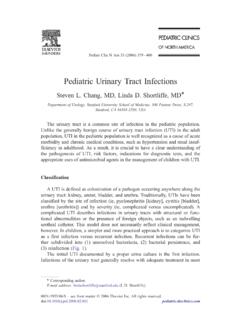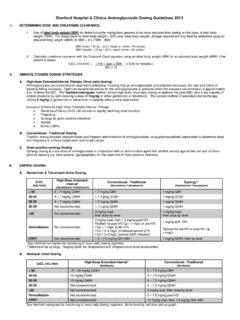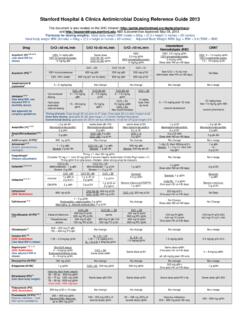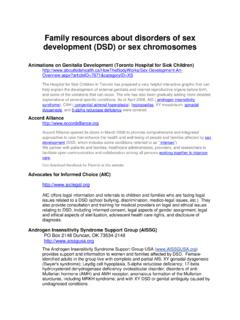Transcription of Pediatric Status Epilepticus Pathway-FINAL - Stanford Medicine
1 Pediatric Status Epilepticus ! Status Epilepticus (SE) is a medical emergency requiring immediate, targeted treatment to help reduce patient morbidity and mortality. SE can be convulsive or non-convulsive, with convulsive Status Epilepticus (CSE) being the most common neurologic medical emergency in childhood. Prognosis is dependent on management of the underlying condition and on prompt treatment of seizures. Definition: The Neurocritical Care Society (Brophy et al 2012) recently defined Status Epilepticus as: "5 minutes or more of (i) continuous clinical and/or electrographic seizure activity or (ii) recurrent seizure activity without recovery (returning to baseline) between seizures.
2 " This is a shorter seizure duration than the previously accepted definition of 30 minutes or longer of continuous seizure activity. The definition was revised since most clinical and electrographic seizures last less than 5 min, and seizures that last longer often to do not stop spontaneously. Animal data also suggest that prolonged seizures are more pharmacoresistant, may cause permanent neuronal injury and are associated with worse cognitive and behavioral outcomes. Refractory Status Epilepticus is generally defined as Status Epilepticus unresponsive to standard treatment regimens, such as initial benzodiazepine followed by an additional anti-epileptic drug (AED).
3 !Outcomes: Overall mortality associated with CSE in childhood has been estimated between 0-16%, with etiology of seizures being the most predictive of outcomes. !Mortality rate in children with pre-existing epilepsy or prolonged febrile seizure is reported to be 0-2%, whereas children with acute symptomatic etiologies are reported to be Mortality is higher in younger children, likely due to higher incidence of CNS infections in this group. !Management Goals: 1. Treatment of SE should begin rapidly, within 5 minutes of seizure onset, and continue sequentially until all clinical and electrographic seizures are terminated, ideally within 60 minutes of onset.
4 2. Etiology of SE should be diagnosed and treated as soon as possible 3. Both treatment and diagnostic evaluation should be started simultaneously !!!!!LPCH Pediatric Status Epilepticus Pathway !Immediate Management (0-5 minutes): Non-invasive airway protection with optimal head/jaw positioning for airway patency and gas exchange. Administer oxygen, consider intubation if deemed necessary for respiratory failure Continuous cardiopulmonary monitoring Establish IV access, finger stick glucose Support blood pressure as needed Obtain pertinent STAT labs: serum chemistries, hematology studies, toxicology screen, AED levels !
5 Emergent Initial AED Therapy (0-5 minutes): all meds to be ordered STAT IV: Lorazepam: mg/kg (max 4 mg) - may repeat in 5 minutes if seizures persist (have 2nd dose drawn up as first dose is being administered) No IV: Midazolam (IM or intranasal): mg/kg up to 10 mg max; OR Diazepam (rectal): mg/kg (2-5 yrs), mg/kg (6-11 yrs), mg/kg ( 12 yrs, max 20 mg) Re-assess in 5 min; order 2nd AED STAT while awaiting response to benzodiazepine If pt is febrile administer rectal or IV acetaminophen (if no liver failure) !
6 If seizures persist (6-10 minutes): Administer 2nd dose of benzodiazepine (if not done already), reassess in 5 min. If no response, administer 2nd AED: For patient 1 month old: Fosphenytoin IV load: 20 mg PE/kg at rate of 3 mg PE/kg/min, max 150 mg/min (if pt is already on PHT, give 10 mg/kg PE IV) For neonate < 1 month old: Phenobarbital IV load: 20 mg/kg at rate of 2 mg/kg/min, max 50 mg/min Re-assess in 10 min; order 3rd AED STAT while awaiting response to 2nd AED Consider potentially treatable conditions (hypoglycemia, hyponatremia, hypocalcemia, hypoxia, intoxication, CNS hemorrhage, CNS infection, hyperthermia) CONSULT Neurology service** !
7 If seizures persist (20 minutes): If 2nd line AED is Fosphenytoin, administer additional Fosphenytoin 10 mg PE/kg IV (total 30 mg PE/kg total), OR If 2nd line AED is Phenobarbitol (neonates), administer additional Phenobarbital 10-20 mg/kg IV (up to 40 mg/kg total) ! !" of 4 2 Status Epilepticus PathwayIf seizures persist (>30 minutes): After 2 AED s (benzodiazepine and second AED) administered with no response, patient is considered to be in refractory SE regardless of elapsed time. !
8 Refractory Status Epilepticus : Administer 3rd AED, such as: Levetiracetam 20-60 mg/kg IV at rate of 5 mg/kg/min (max 3g) Phenobarbital 20 mg/kg IV at rate of 2 mg/kg/min Valproate 20-40 mg/kg IV at rate of 3 mg/kg/min, max 20 mg/min (use with caution for pts < 2 years; do not use if any concerns for liver/metabolic disease) If pt < 2 months old, consider 50-100 mg pyridoxine IV, infused over 1-3 hours !Constantly re-assess airway, breathing, and hemodynamics- support as needed. Sedation, hypotension and respiratory depression are common adverse effects of AEDs.
9 !Once clinical seizures have stopped, consider continuous EEG monitoring to assess for non-convulsive seizures. Do not wait for EEG to continue treatment of clinical seizures. !Continue diagnostic evaluation and treatment of underlying etiology: Common etiologies: sub-therapeutic AED levels, febrile seizures, electrolyte abnormalities, CNS hemorrhage, ischemia, sinus venous thrombosis, CNS infection, autoimmune or post-infectious pathology, intoxication, trauma, metabolic disease, hypertensive crisis Diagnostic studies may include.
10 Serum studies (chemistries, LFTs, toxicology screen, metabolic screen, cultures, CRP, autoimmune serologies), lumbar puncture , neuroimaging (CT, MRI, neuro-vascular imaging). Obtain imaging urgently if neurosurgical emergency (CNS hemorrhage, trauma) is suspected. !If seizures persist after 3rd AED: Goal of therapy is not just cessation of seizures, but to reduce metabolic stress on injured and at-risk cells. Thus it is critical to maintain adequate cerebral perfusion pressure, prevent hyperthermia, and deliver adequate oxygen and nutrients to the cells.









